In November 1958 the Postmaster-General announced that a new set of pictorial stamps would be issued progressively from July 1960.
Issue information
A public competition was held to obtain designs and 1,072 entries were received from 268 competitors. The values in the new set from 1d to 8d were to comprise designs depicting native flora. Due to a change in postage rates 2 1/2d, 5d and 7d denomination stamps were added to this set after the initial stamps were issued. The 1/2d value was designed by Harrison and Sons Ltd, the 1d, 3d and 6d by G F Fuller, the 2d, 4d, 5d and 8d by A G Mitchell, and the 2 1/2d and 7d by the Post Office. All values were printed by Thomas De La Rue, with the exception of the 2 1/2d, 5d and 7d denominations which were printed by Harrison and Sons.
Stamp Bulletin
This stamp issue appeared in the New Zealand Post Stamp Bulletin No. 19 on 3 December 1959.
Acknowledgments: Bulletin scanned and provided by John Biddlecombe of the New Zealand Society of Great Britain. Their web site offers further information useful to those interested in the stamps and postal history of New Zealand. Link: http://www.nzsgb.org.uk/
Product Listing for 1960 Pictorials
| Image | Title | Description | Price |
|---|---|---|---|
| Single Stamp |
Single 1/2d 'Mānuka' gummed stamp. Issued: 1 September 1960. Mānuka (Leptospermum scoparium) also commonly called the tea tree, is a bushy shrub found in most parts of the country. The flowers are mostly white, appear in profusion and often almost hide the small reddish-green leaves. The woody fruit have five narrow slits through which the seeds escape. |
1/2d | |
 |
Single Stamp |
Single 1d 'Karaka' gummed stamp. Issued: 1 September 1960. The karaka (Corynocarpus laevigatus) is a tall tree of the coastal forest and also occurs in picturesque isolated groves casting a welcome shade on rocky foreshores. The dark green glossy leaves reach a length of over 15cm. Inconspicuous greenish flowers give rise to full clusters of richly coloured berries that ripen in strong summer sun. |
1d |
 |
Single Stamp |
Single 2d 'Kōwhai ngutu kākā' gummed stamp. Issued: 11 July 1960. The name kōwhai ngutu kākā shows that the Māori recognised the close relationship between this plant and the yellow kōwhai, at the same time likening its flowers to the beak of a native parrot, the kākā. A soft woody shrub rarely exceeding 1.8 metres, the kākā beak Clianthus puniceus, as it is commonly known, has curved and pointed red flowers about 10 cm long. |
2d |
| Single Stamp |
Single 2 1/2d 'Tītoki' gummed stamp. Issued: 1 November 1960. Tītoki (alectryon excelsus) is a handsome tree, sometimes called the New Zealand Ash. It can reach a height of 18 metres. |
2 1/2d | |
 |
Single Stamp |
Single 3d 'Kōwhai' gummed stamp. Issued: 1 September 1960. Generally regarded as New Zealand's national flower, the yellow kōwhai (Sophora microphylla) is easily grown and is widespread both in its native state and as an ornamental tree in gardens. |
3d |
 |
Single Stamp |
Single 4d 'Puarangi' gummed stamp. Issued: 11 July 1960. Hibiscus trionum, the botanical name of the plant known to the Māori as puarangi, is the smaller of the two New Zealand hibiscus. It belongs to the northern frost-free part of the country and can now be seen only in remote places and on some off-shore islands. |
4d |
 |
Single Stamp |
Single 5d 'Matua Tikumu' gummed stamp. Issued: 14 May 1962. Commonly known as the Mountain Daisy, there are many varieties found in the mountain distrcts of both North and South Islands. The leaves are covered with a velvety coating of fine hairs and the flower rays are white and daisy-like, being up to 100mm in diameter. |
5d |
 |
Single Stamp |
Single 6d 'Pikiarero' gummed stamp. Issued: 1 September 1960. In most lowland forest areas of New Zealand spring is heralded by the flowering of the climber now called Clematis paniculata but formerly known as Clematis indivisa. The white blooms, more than 50mm across are borne in masses when the vines reach the full light of the tree tops or the forest edge. |
6d |
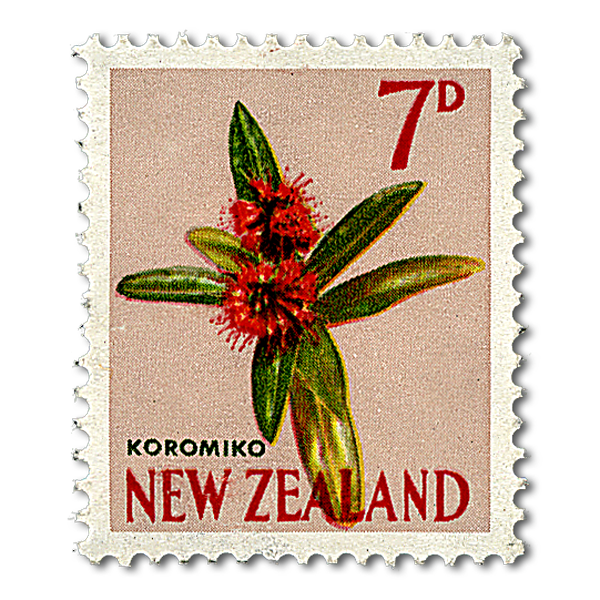 |
Single Stamp |
Single 7d 'Koromiko' gummed stamp. Issued: 16 March 1966. Koromiko or Hebe salicifolia is a native shrub of which there are seven main species. |
7d |
 |
Single Stamp |
Single 8d 'Rātā' gummed stamp. Issued: 1 September 1960. Rātā Metrosideros robusta (northern variety) or Metrosideros umbellata (southern variety), like Mānuka, belongs to the myrtle family. The vines affix themselves to tree trunks and rocks by short roots from the stems. The flowers are conspicuous because of the bunched stamens, which in this species are 25mm long, reddish-orange and tipped with yellow pollen when freshly opened. Flowering amongst the tree tops or in roundish clumps in partly-cleared country, the rātā provides a splash of colour in winter. |
8d |
 |
Single Stamp |
Single 9d 'New Zealand Flag' gummed stamp. Issued: 1 September 1960. New Zealand's national flag, a Blue Ensign bearing the four-star Southern Cross constellation was not adopted for general use until the gazetting of the Royal assent to the New Zealand Ensign Act on 12 June 1902. |
9d |
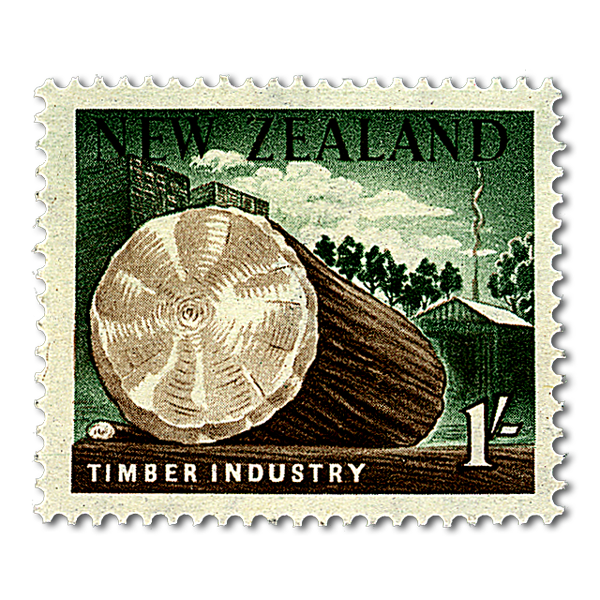 |
Single Stamp |
Single 1s 'Timber Industry' gummed stamp. Issued: 11 July 1960. Although New Zealand was a heavily forested land when the first European settlers arrived, clearance of the land for pastures, deliberate and accidental burning, and the operations of timber mills threatened the extinction of the timber resources. Fortunately, reforestation projects have given an assured future to the timber industry. Both exotic and native timbers are being milled in large quantities for use within the country and for export. The design of the stamp was commissioned by the New Zealand Timber Merchant Federation. |
1s |
 |
Single Stamp |
Single 1s 3d 'Fishing - Trout' gummed stamp. Issued: 11 July 1960. The rainbow trout (Salmo gairdnerii) originally introduced from the Pacific Coast of America has thrived so well in rivers and lakes of the central North Island and high-country lakes of the South Island that angling for fish has become an important tourist attraction. |
1s 3d |
 |
Single Stamp |
Single 1s 6d 'Tiki' gummed stamp. Issued: 11 July 1960. The greenstone hei-tiki was one of the commonest forms of neck pendant worn by Maori of high rank when Europeans first came to New Zealand. Greenstone is an extremely hard material. |
1s 6d |
 |
Single Stamp |
Single 1s 9d 'Aerial Top Dressing (Brown)' gummed stamp. Issued: 11 July 1960. Farming from the air is now an established part of New Zealand's agricultural economy. Operating from 12,000 farm airstrips, aircraft undertake a variety of work which includes topdressing; aerial surveys of noxious weeds; spraying of weeds and crops; airdrops of fencing posts and hay bales for stock; firefighting; laying of chemical fire breaks and poison baits. |
1s 9d |
 |
Single Stamp |
Single 1s 9d 'Aerial Top Dressing (multicoloured)' gummed stamp. Issued: 4 November 1963. Farming from the air is now an established part of New Zealand's agricultural economy. Operating from 12,000 farm airstrips, aircraft undertake a variety of work which includes topdressing; aerial surveys of noxious weeds; spraying of weeds and crops; airdrops of fencing posts and hay bales for stock; firefighting; laying of chemical fire breaks and poison baits. |
1s 9d |
 |
Single Stamp |
Single 2s 'Taniwha' gummed stamp. Issued: 11 July 1960. Although Māori art of the period of first European contact had previously been featured in stamp design, this South Island rock drawing of a taniwha was the first archaeological subject chosen from Māori pre-history to be depicted on a New Zealand stamp. The drawings are in a limestone cave shelter which overlooks the south bank of the Opihi River in South Canterbury. The taniwha is a mythical monster of Māori tradition, which was described as a gigantic man-eating reptile lurking in deep pools. |
2s |
 |
Single Stamp |
Single 2s 6d 'Dairy Industry - Butter' gummed stamp. Issued: 11 July 1960. At the time of issue of this stamp New Zealand manufactured around 220,000 tons of butter a year of which more than three-quarters of this quantity was exported, hence the importance then as now of dairy products to the country's economy. |
2s 6d |
 |
Single Stamp |
Single 3s 'Tongariro National Park & Chateau (sepia)' gummed stamp. Issued: 11 July 1960. This the first of New Zealand's National Parks originated with a gift of the mountain tops of Tongariro (1,968 metres), Ngauruhoe (2,290 metres) and Ruapehu (2,796 metres) by Te Heu heu Tūkino and associated Māori Chiefs in 1887. |
3s |
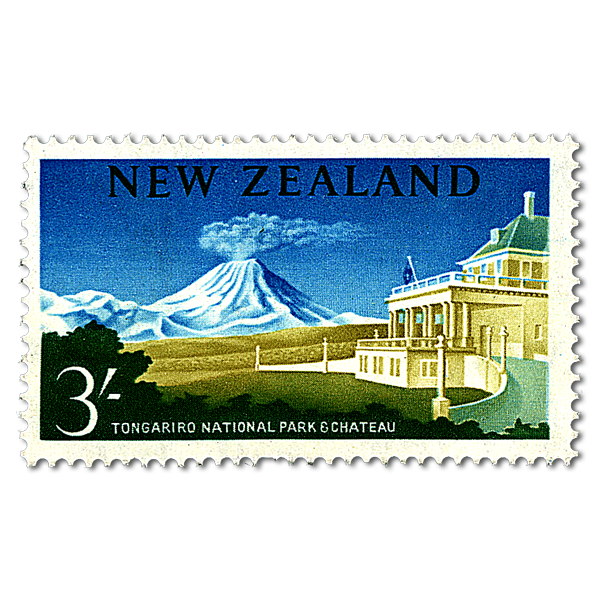 |
Single Stamp |
Single 3s 'Tongariro National Park & Chateau (multi colour)' gummed stamp. Issued: 1 April 1964. This the first of New Zealand's National Parks originated with a gift of the mountain tops of Tongariro (1,968 metres), Ngauruhoe (2,290 metres) and Ruapehu (2,796 metres) by Te Heu heu Tūkino and associated Māori Chiefs in 1887. |
3s |
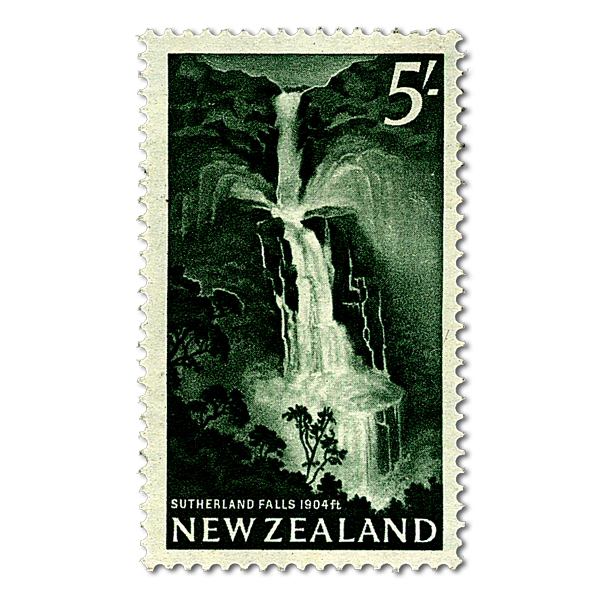 |
Single Stamp |
Single 5s 'Sutherland Falls' gummed stamp. Issued: 11 July 1960. The Sunderland Falls, located in Fiordland National Park, drop from Lake Quill over a steep-walled mountain parapet of the upper Arthur Valley in three successive leaps - the topmost 248 metres, the middle 229 metres, and the lowest 103 metres. |
5s |
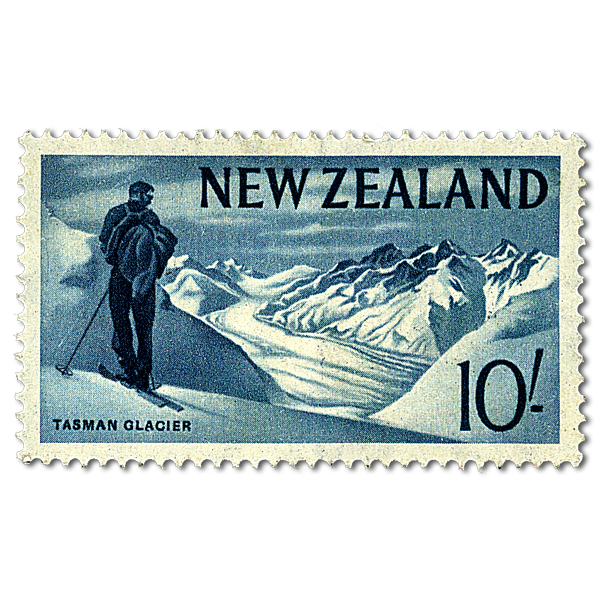 |
Single Stamp |
Single 10s 'Tasman Glacier' gummed stamp. Issued: 11 July 1960. Tasman Glacier, which is not only the largest glacier in New Zealand but also one of the largest in the temperate zone, is in the South Island's Mount Cook National Park. |
10s |
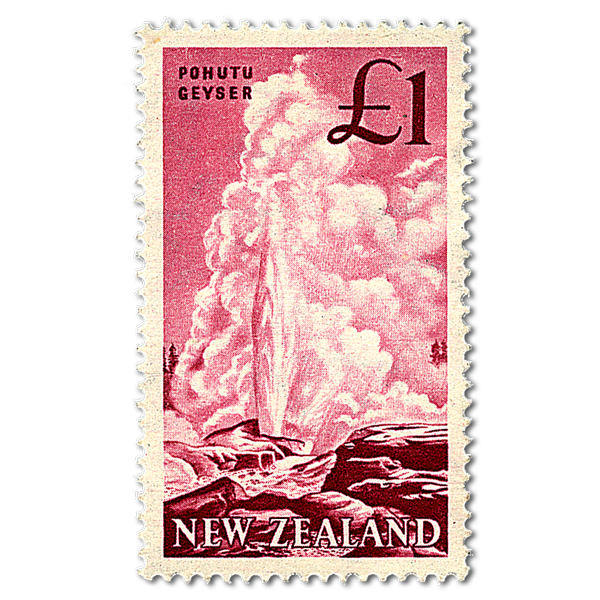 |
Single Stamp |
Single £1 'Pōhutu Geyser' gummed stamp. Issued: 11 July 1960. The giant Pōhutu Geyser at Whakarewarewa, near Rotorua, flings boiling water over 20 metres into the air. It is one of the great attractions of the central North Island's thermal region. |
£1 |
Technical information
| Date of issue: | 11 July 1960 |
|---|---|
| Designers: | Harrison and Sons, G Fuller, A G Mitchell, New Zealand Post Office |
| Printers: | Harrison and Sons, England and Thomas De La Rue, England |
| Stamp size: | 20mm x 24mm |
| Sheet size: | 240 stamps per sheet; Booklets containing both 1/2d and 1d stamps, and 1d and 3d stamps |
| Process: | Photogravure |
| Perforation gauge: | 14.5 x 14 |
| Paper type: | De La Rue printings : Wiggins Teape 'Esparto', multiple NZ and star watermark; Later printings on chalk surfaced variety; Harrison printings : Guard Bridge chalk surfaced, multiple NZ and star watermark. |

